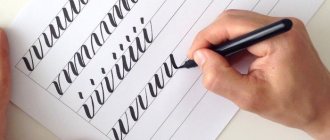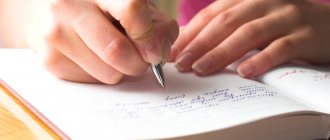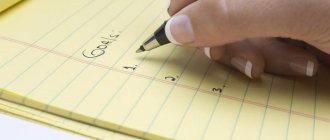The ability to write beautifully is considered a real art, for which a separate term was even created - “calligraphy”. But to achieve success in penmanship, it is not at all necessary to have special talents. All you have to do is be patient and learn a few simple penmanship lessons. In this article we will tell you how to learn to write beautifully and provide step-by-step instructions for improving your handwriting.
Decide why you need it
There can be different reasons for wanting to improve your handwriting.
And you should find yours. Firstly, it will make you act more consciously and increase motivation. And secondly, it will tell you which handwriting nuances you need to focus on correcting. Perhaps you just want to write more legibly. Or you feel the need to make your handwriting more “authoritative”—to give it confidence, clarity, and effectiveness. Or maybe you are driven solely by an aesthetic feeling. Understand yourself, this is important.
Undeveloped motor skills
If elements with curved lines are very distorted, the child most likely has problems with fine motor skills.
Such children “crawl out” beyond the line, their letters are too large or small, and the lines seem to consist of multiple zigzags. Fine motor skills refer to the mobility of fingers and hands. This is an important factor in the child’s readiness to study at school. As a rule, most children experience some difficulty with coordination of movements. Fortunately, the problem is solved quite simply: you need to constantly train, performing special exercises. Before a writing lesson, the teacher usually conducts finger gymnastics, which is included in the teaching methodology for primary school. The exercises may be difficult at first, but doing them regularly will eventually reward you with excellent results.
So, if your son or daughter is experiencing similar difficulties, you need to more often play games aimed at developing fine motor skills. There are a variety of exercises. You can improve your child’s handwriting with the game “Twister”. You need to place a field on the table. The hand with which the baby writes will “dance”, demonstrating various movements, while the other hand can be used to throw the dice. The algorithm is as follows:
- The first player (this could be a parent) rolls two dice at the same time and says which finger he got (drawn white on a dark hand) and color. If the light palm falls out, you can “dance” on the field with the finger with which it is most convenient to do this.
- The second player (child) performs his task, focusing on the thrown dice.
- After this, the participants continue to perform tasks without taking their fingers off the field. Anyone who fails to take the required position is eliminated. Accordingly, the one remaining on the playing field is considered the winner.
Evaluate your current handwriting
Take a piece of paper and write a few sentences on it so that they form two or three paragraphs. Don’t try to write letters “beautifully”, write naturally - the way you always do it.
When finished, place the sheet in front of you and analyze the visible flaws in your handwriting. Do this not in general (“like a chicken paw!”), but trying to highlight specific points.
- Letter shape. Perhaps they are too narrow and angular? Or, on the contrary, overly rounded, with intricate loops? Maybe they duplicate each other - for example, “p” in your version looks like “i”?
- Incline. In classic beautiful handwriting, all letters have the same slight slant to the right.
- Letter height Ideally, it should be the same and such that the icons are readable. And how are you?
- Writing letters. When analyzing, it may turn out that you depict the same element in different ways. A classic example is the difference in the style of the letter “t”: sometimes the printed version is used, and sometimes the written version is used.
- Spacing between letters. It should also be uniform.
- The placement of letters horizontally. They should not jump or go up and down towards the end of the line.
- Pressure. The pressure of the pen on the paper should be uniform throughout the text. But it often happens that in one place we put too much pressure on the pen, and in another, on the contrary, it seems to slide off the paper, which is why the text looks sloppy and difficult to read.
For clarity, you can highlight or outline the most “prominent” areas of the text with a contrasting color. This will help you focus on those shortcomings that you want to get rid of. For example, if you notice that the letter “w” comes out crumpled and compressed at the end, in the future you will try to make it more uniform.
Why is it important to be able to write beautifully and quickly?
It may seem to some that teaching a child to write beautifully or mastering this skill personally is not a very relevant task in the modern world. After all, now most text goes through gadgets and computers; people hold a pencil in their hands less and less often. But here are just some arguments why you need to learn to write beautifully:
- Scientists have proven that writing by hand helps develop mental abilities and the entire brain. Neuroscientists say that writing perfectly develops fine motor skills of the hands and strengthens connections between neurons in the brain. A person who writes a lot is generally more developed;
- Beautiful handwriting makes it easy to write information down on paper and also easy to re-read it. There are often cases when a person supposedly knows how to write, but has difficulty reading what he has written with his own hands. This looks strange and needs fixing.
Learn to write beautifully
It is necessary to be able to write legibly and clearly, because gadgets, Google, voice prompts and other joys of modern civilization may not always be at hand.
Find inspiration
Beauty is a relative concept, and “beautiful” (in your opinion) handwriting can be completely different. Look for an example of one you like.
Perhaps these will just be perfectly even “school” lines:
900igr.net
Or elegant calligraphic:
Youtube channel AlphabetMan
Or maybe you crave originality and prefer handwriting slanted to the left? If possible, print out the examples you find and place them where you can see them. For example, hang it on the refrigerator door. Attach it as a sticker to your monitor. Or above the desktop.
This will help “correct” handwriting stick in your visual memory and encourage you to subconsciously copy “good” examples.
Features of the central nervous system
There are diseases when difficulties with writing remain for life. For example, in the case of dyslexia, when mastering the required skills is significantly difficult.
Thus, to help a child improve handwriting, you must first understand the reason. Calligraphy may be impaired due to certain features of the nervous system. In such cases, it is advisable not to force the child to rewrite the text several times, but to show it to a medical specialist who will give valuable recommendations and help solve the problem.
Do exercises for your hands
Handwriting is responsible for what physiologists call fine motor skills - a set of coordinated actions of the hand and fingers. If you try hard, but your handwriting is in trouble, then perhaps the problem is in your motor skills. There is only one way out: train your hands.
Among the most effective and at the same time simplest methods is air letter. Take a pen or pencil, bend your elbow (at an angle of about 70-80 degrees) and start writing imaginary words in the air. Make the letters large - in this case, when writing, not only the hand and fingers will be involved, but also the entire limb from the shoulder, including the wrist and forearm. This is important: you will tire less if you write with your whole hand, and this will keep your handwriting clearer and more even.
Such exercises should be done regularly. For example, spend 3-5 minutes on them in the morning, afternoon and evening.
How long does it take to change your writing style?
The rate of change will depend on three factors:
- final goal;
- teaching methods;
- pure practice time.
If you are faced with the task of radically changing your writing style, do not expect quick results. It will take 2-3 months to get used to writing numbers and letters in a new way, forming the individual beauty of handwriting.
Daily exercise is important: even for 5 minutes, but every day.
If a small correction is required, the first successes can be noticed after 3-4 weeks, but only if the training method is chosen correctly. On average, teachers provide the following data: by studying for 8 hours daily, the first results can be seen within a month.
Make sure you are holding your pen or pencil correctly
YouTube channel “I want to know everything”
The writing utensil should lie on the left side of the middle finger of your right hand (if you are left-handed, on the right side of the middle finger of your left hand). The tip of the index finger holds the pen or pencil on top. The large one supports on the left (for left-handed people - on the right). When you write, your hand should rest on the top joint of your bent little finger.
All three fingers holding a pen or pencil are slightly rounded and do not grip the stationery too tightly.
To check your grip is correct, lift your index finger. The pen (pencil) should not fall.
Body position and inappropriate desk
Poor handwriting is often caused by poor posture, unnatural pen angle or notebook placement. In order to write quickly and clearly, you need to follow these rules . You need to sit straight so that your torso, shoulders and head are in a level position. Your back rests on the back of the chair, your feet are on the floor. Under no circumstances should your chest touch the table; your elbows should go beyond its edge.
Children often sit in the wrong way, copying their neighbor at the desk. They easily forget what their parents told them at home. To accustom your baby to the correct position, you need to spend some time on this and explain that the body quickly gets used to the correct position. The child must understand that discomfort will be felt only at first, and then addiction will set in, after which he will no longer have to make any efforts and control himself.
School desks are made to an accepted standard, so they cannot be incorrect. In accordance with the standards, the tabletop should be located slightly below the solar plexus and have a slight angle. The desk itself has a durable and stable design. If parents doubt its quality, they can attend a lesson and make sure that everything is fine, or transplant the baby to where it will be better for him. Children have different heights, so the teacher selects the most suitable place for each child. Well, at home you need to properly organize the student’s workplace.
Practice writing basic lines
Before you start drawing beautiful letters, make sure your hand remembers how to write the basic elements. We are talking about simple vertical and diagonal lines, circles, semicircles.
Only after you learn how to automatically display precise lines and curls should you move on to the text.
You can train using special recipes, including those designed for future first-graders. Such manuals are sold in office supply stores and on the Internet. A big plus of copybooks is that they are marked with lines that will help you control the slope and size of your elements.
labirint.ru
Another option to improve your skills is doodling. This is the name for an amateur drawing technique based on intuitively selected patterns. You can do doodling anywhere: at a meeting, on public transport, while talking on the phone. All you need is a pen and a notepad, the pages of which you will fill with intuitive patterns.
YouTube channel camellia8885
Doodling develops coordination of movements and the habit of smoothly moving a pen or pencil on paper. And with this technique you can create real masterpieces. But that's a slightly different story.
Common Mistakes
- Incorrect posture, posture . Always sit correctly. Back problems are an insidious thing; they creep up slowly and unnoticed until it is too late. While learning to write, it is very easy to develop back pain, and when it appears, nothing can be done about it. So watch your posture.
- Handwriting is too complex . At first, choose a simpler handwriting. If you choose complex handwriting, you will be more likely to quit your idea before you achieve significant results. Remember that you are not limited to just one handwriting - once you learn simple writing, you can take on something more complex.
- Moving too quickly to complex tasks . The art of beautiful handwriting is achieved through painstaking, diligent and methodical training. Don't jump to words without learning the letters - not only will it be difficult for you, you will also begin to reinforce your mistakes. Spend more time on letters and move on to words only when the letters have already been thoroughly worked out.
Fake calligraphy
Fake calligraphy is cursive that will teach you how to use a fountain pen. This is an important technique for gaining the skill of writing on any surface. It takes more time than working with a fountain pen, but if your goal is a simple phrase, then you will definitely appreciate the result. Fake calligraphy is an easy and fun way to learn the basics of calligraphy. By the way, people often do not distinguish it from the genuine one.
First, write a phrase in regular cursive as best you can. Then draw lines to indicate the thickening. They appear by moving your hand down or up to create part of the letter (parallel to it). After marking all the bulges, you need to fill in the empty areas. Ready!
Definition of the concept
Calligraphy is the art of designing characters in a masterly, harmonious and expressive manner. Literally translated as “beautiful handwriting.”
For the first time, the term, which denoted writing that stands out for its beauty and clarity, was mentioned in Europe in the sixteenth century. But the origins of this art were discovered long before such writing received a name. De facto, calligraphy originated and began to develop when people just started using symbols to convey information. An example of the art of writing in beautiful and even handwriting is hieroglyphs (four thousand years BC). The writing of the Egyptians was supplanted by the Greeks in the third century BC, and from about this point onwards writing with different techniques is observed in all parts of the world.
Nowadays, the main forms of calligraphy are cards, wedding greetings, fonts, graffiti and graphic design. However, its importance in the same educational process is clearly underestimated. Among large Japanese companies, calligraphy lessons for employees during lunch breaks are common. According to company executives, this expensive activity is good for health and creativity. But the Japanese are the most efficient, creative in the field of development and advanced nation. Back in the 80s of the last century, calligraphy won an interesting experiment by one of the largest companies (we are still talking about Japan), the goal of which was to find methods for training specialists of the future.
Calligraphic handwriting refers to the technique of legible, neat writing. Teachers, archive workers, librarians are examples of professions for which calligraphy is a necessity, not a whim.
Introductory video tutorial.











